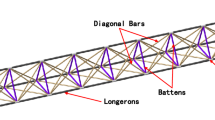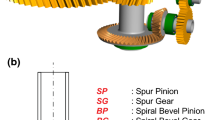Abstract
The star-wheel reducer has been regarded as a promising alternative solution for industrial power transmission where large transmission ratio and high power density are required. As one of the most overwhelming concerns in the early design stage of such kind of transmission device, its dynamic performance must be evaluated in advance to provide guidelines for vibration suppression and tolerance control. For this purpose, this paper proposes a methodology of dynamic modeling for the star-wheel reducer and analyzes the dynamic behaviors of the transmission system. By using the technique of substructure synthesis, an analytical elasto-dynamic model is established in which the effects of component compliances and manufacturing/assembling errors are included. The differential motion equations of each subsystem are derived with the 2nd Newtonian law. These differential motion equations are further assembled by the compatibility conditions among the subsystems to formulate a governing equation of the overall transmission system. Based on the established dynamic model, a modal analysis and a dynamic analysis are carried out to reveal the modal characteristics and the steady-state responses of the star-wheel reducer. The results show that the first 6 orders natural frequencies are ranging from 66.2 to 197 Hz and are much higher than the reducer’s input frequency of 16.7 Hz under input speed of 1000 r/min. In addition, the meshing forces of the two phases of star-wheel are similar only with a phase difference of 180°. Finally, a test-rig is set up to perform an experimental modal test and a vibration test. The satisfactory agreement between the experimental data and the theoretical simulation results proves the correctness and accuracy of the proposed dynamic model. The present study is expected to provide a fundamental framework for error controlling and performance enhancement of the star-wheel reducer.
Zusammenfassung
Das Sternradgetriebe gilt als vielversprechende Alternative für die industrielle Kraftübertragung, bei der große Übersetzungsverhältnisse und eine hohe Leistungsdichte gefordert sind. Als eines der überwältigendsten Anliegen in der frühen Entwurfsphase eines solchen Getriebegeräts muss dessen dynamisches Verhalten im Voraus bewertet werden, um Richtlinien für die Unterdrückung von Vibrationen und die Toleranzkontrolle bereitzustellen. Zu diesem Zweck wird in diesem Artikel eine Methodik zur dynamischen Modellierung des Sternradgetriebes vorgeschlagen und das dynamische Verhalten des Getriebesystems analysiert. Unter Verwendung der Technik der Substruktursynthese wird ein analytisches elastodynamisches Modell erstellt, in das die Auswirkungen von Bauteilübereinstimmungen und Fertigungs- / Montagefehlern einbezogen werden. Die Differentialbewegungsgleichungen jedes Subsystems werden mit dem 2. Newtonschen Gesetz abgeleitet. Diese Differentialbewegungsgleichungen werden ferner durch die Kompatibilitätsbedingungen zwischen den Teilsystemen zusammengesetzt, um eine maßgebliche Gleichung des gesamten Übertragungssystems zu formulieren. Basierend auf dem etablierten dynamischen Modell werden eine Modalanalyse und eine dynamische Analyse durchgeführt, um die Modaleigenschaften und die stationären Reaktionen des Untersetzungsgetriebes aufzudecken. Die Ergebnisse zeigen, dass die Eigenfrequenzen der ersten 6 Ordnungen im Bereich von 66.2 bis 197 Hz liegen und viel höher sind als die Eingangsfrequenz des Reduzierers von 16.7 Hz bei einer Eingangsgeschwindigkeit von 1000 r/min. Außerdem sind die Eingriffskräfte der beiden Phasen des Sternrades nur mit einer Phasendifferenz von 180° ähnlich. Schließlich wird ein Prüfstand eingerichtet, um einen experimentellen Modaltest und einen Vibrationstest durchzuführen. Die zufriedenstellende Übereinstimmung zwischen den experimentellen Daten und den theoretischen Simulationsergebnissen beweist die Richtigkeit und Genauigkeit des vorgeschlagenen dynamischen Modells. Die vorliegende Studie soll einen grundlegenden Rahmen für die Fehlerkontrolle und Leistungssteigerung des Sternradgetriebes bieten.














Similar content being viewed by others
References
Liang X, Zuo MJ, Feng Z (2018) Dynamic modeling of gearbox faults: a review. Mech Syst Signal Process 98:852–876
Liu X, Yang Y, Zhang J (2018) Resultant vibration signal model based fault diagnosis of a single stage planetary gear train with an incipient tooth crack on the sun gear. Renew Energy 122:65–79
Yi Y, Qin D, Liu C (2018) Investigation of electromechanical coupling vibration characteristics of an electric drive multistage gear system. Mech Mach Theory 121:446–459
Leque N, Kahraman A (2017) A three-dimensional load sharing model of planetary gear sets having manufacturing errors. J Mech Des N Y 139(3):33302
Cooley CG, Parker RG (2018) Eigenvalue sensitivity and veering in gyroscopic systems with application to high-speed planetary gears. Eur J Mech A Solids 67:123–136
Tsai SJ, Chang LC, Huang CH (2017) Design of cycloid planetary gear drives with tooth number difference of two. Forsch Ingenieurwes 81(2–3):325–336
Yang J, Zhang C (2005) Elasto-dynamics of internal gear planetary transmissions. Mech Mach Theory 40(10):1107–1125
Huang C, Wang JX, Xiao K et al (2013) Dynamic characteristics analysis and experimental research on a new type planetary gear apparatus with small tooth number difference. J Mech Sci Techol 27(5):1233–1244
Li H, Niu W, Zhang D et al (2014) Effect of modification coefficient on nonlinear dynamic characteristics of planetary drive with small teeth number difference. J Vibroengineering 16(1):90–102
Dai L, Pu W, Wang J (2018) Mixed EHL analysis of planetary drives with small teeth number difference considering real tooth geometry. Lubr Sci 30(6):317–330
Li S (2008) Contact problem and numeric method of a planetary drive with small teeth number difference. Mech Mach Theory 43(9):1065–1086
Shu XL (1995) Determination of load sharing factor for planetary gearing with small tooth number difference [J. Mech Mach Theory 30(2):313–321
Acknowledgements
This work was sponsored by National Natural Science Foundation of China (Grant No. 51875105).
Author information
Authors and Affiliations
Corresponding author
Appendix
Appendix
The elements of the mass, stiffness, load and displacement matrix in Eq. 8 are as follows,
Further, M, K, F and X matrix are composed of the parameters of each subsystem, as shown below:
1.1 Output shaft subsystem
\(m_{\mathrm{o}}=\left[\begin{array}{lllll} m_{\mathrm{o}} & & & & \\ & m_{\mathrm{o}} & & & \\ & & j_{\mathrm{o}x} & & \\ & & & j_{\mathrm{o}y} & \\ \mathrm{sym} & & & & j_{\mathrm{o}z} \end{array}\right]\), \(x_{\mathrm{o}}=\left[\begin{array}{l} x_{\mathrm{o}}\\ y_{\mathrm{o}}\\ \beta _{\mathrm{o}x}\\ \beta _{\mathrm{o}y}\\ \beta _{\mathrm{o}z} \end{array}\right]\), \(f_{\mathrm{o}}=\left[\begin{array}{l} 0\\ - g_{\mathrm{o}}\\ 0\\ 0\\ - T_{\mathrm{o}} \end{array}\right]\), \(k_{\mathrm{oI}}=k_{\mathrm{I}2}\left[\begin{array}{llll} - 1 & & & a_{2}\\ & - 1 & - a_{2} & 0\\ & c_{3} & a_{2}c_{3} & 0\\ - c_{3} & & & a_{2}c_{3}\\ 0 & 0 & 0 & 0 \end{array}\right]\), \(k_{\mathrm{op}i}=- k_{\mathrm{m}}\sum _{i=1}^{2}\left[\begin{array}{lll} \sin ^{2}\psi _{i} & \sin \psi _{i}\cos \psi _{i} & r_{\mathrm{bp}}\sin \psi _{i}\\ \sin \psi _{i}\cos \psi _{i} & \cos ^{2}\psi _{i} & r_{\mathrm{bp}}\cos \psi _{i}\\ - c_{i+3}\sin \psi _{i}\cos \psi _{i} & - c_{i+3}\cos ^{2}\psi _{i} & - c_{i+3}r_{\mathrm{bp}}\cos \psi _{i}\\ c_{i+3}\sin ^{2}\psi _{i} & c_{i+3}\sin \psi _{i}\cos \psi _{i} & c_{i+3}r_{\mathrm{bp}}\sin \psi _{i}\\ r_{b}\sin \psi _{i} & r_{b}\cos \psi _{i} & r_{b}r_{\mathrm{bp}} \end{array}\right]\), \(k_{\mathrm{o}}=k_{\mathrm{o}}^{1}+k_{\mathrm{o}}^{2}+k_{\mathrm{o}}^{3}\), \(k_{\mathrm{o}}^{1}=\sum _{i=1}^{2}\left[\begin{array}{lllll} k_{\mathrm{o}i} & 0 & 0 & \left(- 1\right)^{i+1}k_{\mathrm{o}i}c_{i} & 0\\ & k_{\mathrm{o}i} & - \left(- 1\right)^{i+1}k_{\mathrm{o}i}c_{i} & 0 & 0\\ & & k_{\mathrm{o}i}c_{i}^{2} & 0 & 0\\ & & & k_{\mathrm{o}i}c_{i}^{2} & 0\\ \mathrm{sym} & & & & 0 \end{array}\right]\), \(k_{\mathrm{o}}^{2}=k_{\mathrm{I}2}\left[\begin{array}{lllll} 1 & 0 & 0 & c_{3} & 0\\ & 1 & - c_{3} & 0 & 0\\ & & c_{3}^{2} & 0 & 0\\ & & & c_{3}^{2} & 0\\ \mathrm{sym} & & & & 0 \end{array}\right]\), \(k_{\mathrm{o}}^{3}=k_{\mathrm{m}}\sum _{i=1}^{2}\left[\begin{array}{lllll} \sin ^{2}\psi _{i} & \sin \psi _{i}\cos \psi _{i} & - c_{i+3}\sin \psi _{i}\cos \psi _{i} & c_{i+3}\sin ^{2}\psi _{i} & r_{\mathrm{b}}\sin \psi _{i}\\ \sin \psi _{i}\cos \psi _{i} & \cos ^{2}\psi _{i} & - c_{i+3}\cos ^{2}\psi _{i} & c_{i+3}\sin \psi _{i}\cos \psi _{i} & r_{\mathrm{b}}\cos \psi _{i}\\ - c_{i+3}\sin \psi _{i}\cos \psi _{i} & - c_{i+3}\cos ^{2}\psi _{i} & c_{i+3}^{2}\cos ^{2}\psi _{i} & - c_{i+3}^{2}\sin \psi _{i}\cos \psi _{i} & - c_{i+3}r_{\mathrm{b}}\cos \psi _{i}\\ c_{i+3}\sin ^{2}\psi _{i} & c_{i+3}\sin \psi _{i}\cos \psi _{i} & - c_{i+3}^{2}\sin \psi _{i}\cos \psi _{i} & c_{i+3}^{2}\sin ^{2}\psi _{i} & c_{i+3}r_{\mathrm{b}}\sin \psi _{i}\\ r_{b}\sin \psi _{i} & r_{b}\cos \psi _{i} & - c_{i+3}r_{\mathrm{b}}\cos \psi _{i} & c_{i+3}r_{\mathrm{b}}\sin \psi _{i} & r_{b}^{2} \end{array}\right]\)
1.2 Input shaft subsystem
\(m_{\mathrm{I}}=\left[\begin{array}{llll} m_{\mathrm{I}} & & & \\ & m_{\mathrm{I}} & & \\ & & j_{\mathrm{I}x} & \\ \mathrm{sym} & & & j_{\mathrm{I}y} \end{array}\right]\), \(x_{\mathrm{I}}=\left[\begin{array}{l} x_{\mathrm{I}}\\ y_{\mathrm{I}}\\ \beta _{\mathrm{I}x}\\ \beta _{\mathrm{I}y} \end{array}\right]\), \(f_{\mathrm{I}}=f_{\mathrm{I}1}+f_{\mathrm{I}2}\), \(f_{\mathrm{I}1}=\left[\begin{array}{l} 0\\ - g_{\mathrm{I}}\\ m_{e\mathrm{I}}e\omega ^{2}\sin \varphi _{1}\left(a_{3}+a_{4}\right)\\ - m_{e\mathrm{I}}e\omega ^{2}\cos \varphi _{1}\left(a_{3}+a_{4}\right) \end{array}\right]\), \(f_{\mathrm{I}2}=- k_{\mathrm{a}}\sum _{i=1}^{2}\left[\begin{array}{ll} 1 & 0\\ 0 & 1\\ 0 & a_{i+2}\\ - a_{i+2} & 0 \end{array}\right]\left(G_{i}+H_{i}\right)\), \(k_{\mathrm{Io}}=k_{\mathrm{I}2}\left[\begin{array}{lllll} - 1 & 0 & 0 & - c_{3} & 0\\ 0 & - 1 & c_{3} & 0 & 0\\ 0 & - a_{2} & c_{3}a_{2} & 0 & 0\\ a_{2} & 0 & 0 & c_{3}a_{2} & 0 \end{array}\right]=(k_{\mathrm{oI}})^{\mathrm{T}}\),
\(k_{\mathrm{Ip}i}=- k_{\mathrm{a}}\left[\begin{array}{lll} 1 & & 0\\ & 1 & 0\\ & a_{i+2} & 0\\ - a_{i+2} & & 0 \end{array}\right]=(k_{\mathrm{pI}i})^{\mathrm{T}}\)
1.3 Star-wheel shaft subsystem
\(m_{\mathrm{s}j}=\left[\begin{array}{lllll} m_{\mathrm{s}j} & & & & \\ & m_{\mathrm{s}j} & & & \\ & & j_{\mathrm{s}xj} & & \\ & & & j_{\mathrm{s}yj} & \\ \mathrm{sym} & & & & j_{\mathrm{s}zj} \end{array}\right]\), \(x_{\mathrm{s}j}=\left[\begin{array}{l} x_{\mathrm{s}j}\\ y_{\mathrm{s}j}\\ \beta _{\mathrm{s}xj}\\ \beta _{\mathrm{s}yj}\\ \beta _{\mathrm{s}zj} \end{array}\right]\), \(f_{\mathrm{s}j}=f_{\mathrm{s}j1}+f_{\mathrm{s}j2}\), \(f_{\mathrm{s}j1}=\left[\begin{array}{l} 0\\ - g_{s}\\ - m_{es}e\omega ^{2}\sin \varphi _{1}\left(b_{3}+b_{4}\right)\\ m_{es}e\omega ^{2}\cos \varphi _{1}\left(b_{3}+b_{4}\right)\\ 0 \end{array}\right]\), \(f_{\mathrm{s}j2}=- k_{\mathrm{p}}\sum _{i=1}^{2}\left[\begin{array}{ll} 1 & \\ & 1\\ & - b_{i+2}\\ b_{i+2} & \\ - e\sin \varphi _{i} & e\cos \varphi _{i} \end{array}\right]\left(U_{ij}+V_{ij}\right)\),
1.4 The i th phase star-wheel subsystem
\(m_{\mathrm{p}i}=\left[\begin{array}{lll} m_{\mathrm{p}i} & & \\ & m_{\mathrm{p}i} & \\ \mathrm{sym} & & j_{\mathrm{p}zi} \end{array}\right]\), \(f_{\mathrm{p}i1}=\left[\begin{array}{l} 0\\ - g_{\mathrm{p}}\\ 0 \end{array}\right]\), \(f_{\mathrm{p}i2}=\left[\begin{array}{l} m_{\mathrm{p}}e\omega ^{2}\cos \varphi _{i}\\ m_{\mathrm{p}}e\omega ^{2}\sin \varphi _{i}\\ 0 \end{array}\right]\), \(f_{\mathrm{p}i3}=k_{\mathrm{a}}\left[\begin{array}{ll} 1 & 0\\ 0 & 1\\ 0 & 0 \end{array}\right](G_{i}+H_{i})\)
\(f_{\mathrm{p}i4}=k_{\mathrm{p}}\sum _{j=1}^{m}\left[\begin{array}{ll} 1 & 0\\ 0 & 1\\ - L\sin \phi _{j} & L\cos \phi _{j} \end{array}\right]\left(U_{ij}+V_{ij}\right)\), \(x_{\mathrm{p}i}=\left[\begin{array}{l} x_{\mathrm{p}i}\\ y_{\mathrm{p}i}\\ \theta _{\mathrm{p}i} \end{array}\right]\), \(k_{\mathrm{pI}i}=- k_{\mathrm{a}}\left[\begin{array}{llll} 1 & 0 & 0 & - a_{i+2}\\ 0 & 1 & a_{i+2} & 0\\ 0 & 0 & 0 & 0 \end{array}\right]\)\(k_{\mathrm{p}i}^{1}=k_{\mathrm{m}}\left[\begin{array}{lll} \sin ^{2}\psi _{i} & \sin \psi _{i}\cos \psi _{i} & r_{\mathrm{bp}}\sin \psi _{i}\\ \sin \psi _{i}\cos \psi _{i} & \cos ^{2}\psi _{i} & r_{\mathrm{bp}}\cos \psi _{i}\\ r_{\mathrm{bp}}\sin \psi _{i} & r_{\mathrm{bp}}\cos \psi _{i} & r_{\mathrm{bp}}^{2} \end{array}\right]\), \(k_{\mathrm{p}i}^{2}=k_{\mathrm{p}}\left[\begin{array}{lll} m & 0 & 0\\ 0 & m & 0\\ 0 & 0 & mL^{2} \end{array}\right]\), \(k_{\mathrm{p}i}^{3}=k_{\mathrm{a}}\left[\begin{array}{lll} 1 & 0 & 0\\ 0 & 1 & 0\\ 0 & 0 & 0 \end{array}\right]\), \(k_{\mathrm{po}i}=- k_{\mathrm{m}}\left[\begin{array}{lllll} \sin ^{2}\psi _{i} & \sin \psi _{i}\cos \psi _{i} & - c_{i+3}\sin \psi _{i}\cos \psi _{i} & c_{4,5}\sin ^{2}\psi _{i} & r_{\mathrm{b}}\sin \psi _{i}\\ \sin \psi _{i}\cos \psi _{i} & \cos ^{2}\psi _{i} & - c_{i+3}\cos ^{2}\psi _{i} & c_{i+3}\sin \psi _{i}\cos \psi _{i} & r_{\mathrm{b}}\cos \psi _{i}\\ r_{\mathrm{bp}}\sin \psi _{i} & r_{\mathrm{bp}}\cos \psi _{i} & - c_{i+3}r_{\mathrm{bp}}\cos \psi _{i} & c_{4,5}r_{\mathrm{bp}}\sin \psi _{i} & r_{\mathrm{bp}}r_{\mathrm{b}} \end{array}\right]\)
\(k_{\mathrm{ps}ij}=- k_{\mathrm{p}}\sum _{j=1}^{m}\left[\begin{array}{lllll} 1 & 0 & 0 & b_{i+2} & - e\sin \varphi _{i}\\ 0 & 1 & - b_{i+2} & 0 & e\cos \varphi _{i}\\ - L\sin \phi _{j} & L\cos \phi _{j} & - L\cos \phi _{j}b_{i+2} & - L\sin \phi _{j}b_{i+2} & eL\cos \varphi _{i}\cos \phi _{j}+eL\sin \varphi _{i}\sin \phi _{j} \end{array}\right]x_{\mathrm{s}j}\), \(k_{\mathrm{p}i}=k_{\mathrm{p}i}^{1}+k_{\mathrm{p}i}^{2}+k_{\mathrm{p}i}^{3}\), \(f_{\mathrm{p}i}=f_{\mathrm{p}i1}+f_{\mathrm{p}i2}+f_{\mathrm{p}i3}+f_{\mathrm{p}i4}\)
Rights and permissions
About this article
Cite this article
Wang, J., Zhang, J. Dynamic Modeling and Analysis of a Star-wheel Reducer. Forsch Ingenieurwes 83, 491–507 (2019). https://doi.org/10.1007/s10010-019-00365-2
Received:
Accepted:
Published:
Issue Date:
DOI: https://doi.org/10.1007/s10010-019-00365-2




